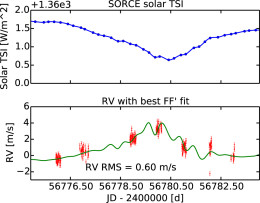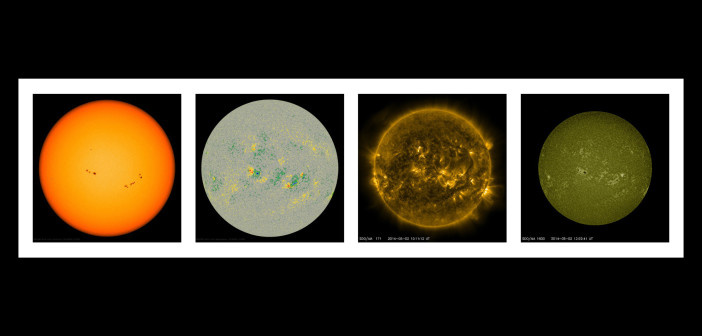Looking for stars that “wobble” is one of the key ways by which we detect exoplanets: the gravitational pull of planets cause tiny variations in stars’ radial velocities. But our ability to detect Earth twins is currently limited by our ability to distinguish between radial-velocity variations caused by exoplanets, and those caused by noise from the star itself. A team of scientists has recently proposed that the key to solving this problem may be to examine our own star.
Precision Amid Noise
The radial-velocity technique works well for detecting large planets on close orbits, but detecting an Earth twin requires being able to detect star motion on the order of 10 cm/s! This precision is hard to reach, because activity on the stellar surface — i.e., sunspots, plages (bright spots), or granulation — can also cause variations in the measured radial velocity for the star, obscuring the signature of a planet.
Because the stars we’re examining aren’t resolved, we can’t track the activity on their surfaces — so how can we better understand the imprint that stellar activity has on radial-velocity measurements? A team of scientists has come up with a clever approach: examine the Sun as though it were a distant star.
Wealth of Information
The team, led by Xavier Dumusque (Branco-Weiss Fellow at the Harvard-Smithsonian Center for Astrophysics) and David F. Phillips (Harvard-Smithsonian Center for Astrophysics), has begun a project to observe the Sun with a ground-based solar telescope. The telescope observes the full disk of the Sun and feeds the data into the HARPS-N spectrograph in Spain, a spectrograph normally used for radial-velocity measurements of other stars in the hunt for exoplanets.
But the team has access to other data about the Sun, too: information from satellites like the Solar Dynamics Observatory and SORCE about the solar activity and total irradiance during the time when the spectra were taken. Dumusque and collaborators have combined all of this information, during a week-long test, to see if it’s possible to correct for radial-velocity perturbations due to sunspots and plages.
Reducing Variations

The total solar irradiance of the Sun (top panel) is correlated with the radial velocity variations measured for the Sun (bottom panel), due to the effects of surface inhomogeneities like sunspots and plages. [Dumusque et al. 2015]
After this initial success, the next step is to improve on this result with more extensive observations. The team plans to continue to monitor the Sun daily over the next two to three years, allowing them to further develop correction methods. They believe this will enable us to reach the precision needed to detect an Earth twin around another star.
Citation
Xavier Dumusque et al 2015 ApJ 814 L21. doi:10.1088/2041-8205/814/2/L21

